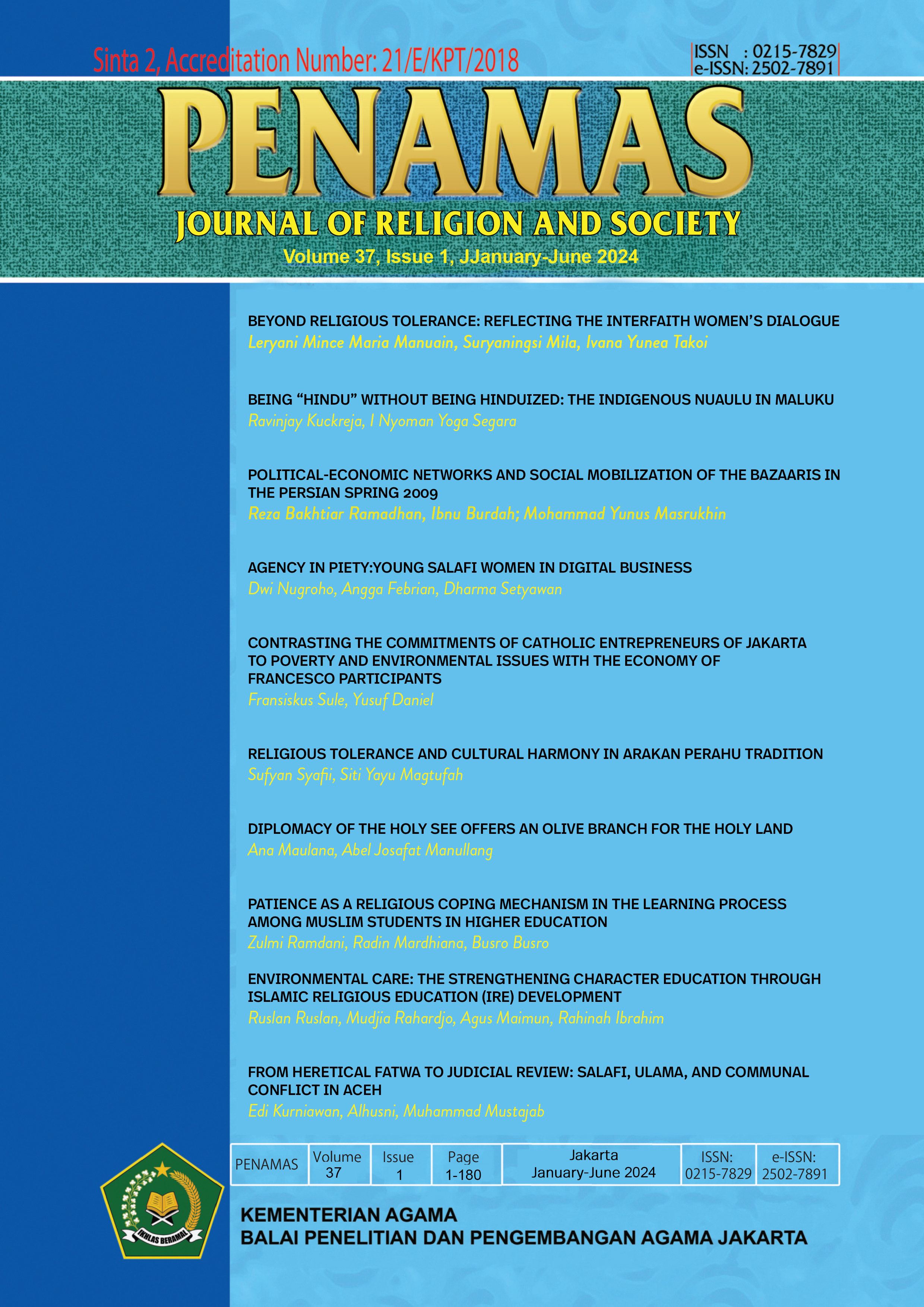BEYOND RELIGIOUS TOLERANCE: REFLECTING THE INTERFAITH WOMEN’S DIALOGUE
DOI:
https://doi.org/10.31330/penamas.v37i1.743Keywords:
interfaith dialogue, women’s dialogue, religious tolerance , KupangAbstract
With its diversity in ethnicity and religion, some parts of Indonesia tend to be vulnerable to conflicts. This research aims to reveal the practice of religious tolerance and the active role of interfaith women in maintaining religious tolerance through daily dialogue. It emphasizes the significant participation of interfaith women in fostering religious tolerance. This study collected data from interfaith women in the Fatubesi subdistrict area of Kupang City using interviews and observation. The results show that interfaith women in Fatubesi, especially in the Oeba traditional market, live in harmonious and peaceful relationships. They have practiced the spirit of sisterhood and friendship in their daily encounters. Even though they are rarely involved in formal dialogue, women are active in a dialogue of life through daily interactions in informal spaces. They are connected in solidarity through openness, acceptance, respect, and helping one another. Furthermore, interfaith women are active peacekeepers through their activities of sharing food and other basic needs in their neighborhoods and during their religious celebrations. Therefore, the activism of interfaith women in the Fatubesi area is a practice that goes beyond religious tolerance.
References
Al-Qurtuby, S. (2014). Religious Women For Peace and Reconciliation in Contemporary Indonesia. International Journal on World Peace XXXI, No.1.
Attaulah, S. (1997). Christian-Muslim Dialogue in the Twentieth Century. London: Macmillan Press.
Ayoub, M. (2004). Christian-Muslim Dialogue: Goals and Obstacles. The Muslim World, 313-319.
Banawiratma, Johannes B, and Zainal Abidin Bagir, eds. Dialog antarumat beragama: gagasan dan praktik di Indonesia. Jakarta & Yogyakarta: Kerjasama Mizan Publika dan Program Studi Agama dan Lintas Budaya (Center for Religious and Cross-Cultural Studies), Sekolah Pascasarjana Universitas Gadjah Mada ; Didistribusikan oleh Mizan Media Utama, 2010.
Bowlin, John R. (2016). Tolerance Among the Virtues. Princeton & Oxford: Princeton University Press.
Chaundry, A. S. (2013). Women Building Interfaith Bridges: A Study of Three Interfaith Organizations. Journal of Muslim Minority Affairs, 56-69.
Fakih, Mansour. (1996). Analisis Gender & Transformasi Sosial. Yogyakarta: Pustaka Pelajar.
Fletcher, Jeannine Hill. (2013) “Women in Inter-Religious Dialogue.” In The Wiley-BlacINTERkwell Companion to Inter-Religious Dialogue, edited by Catherine Cornille. USA: Jhon Willey & Sons Ltd,.
Maria Hornung, (2007), Encountering Other Faiths, (New York: Paulist Press.
O'neill, Maura, (2007), Mending a Torn World: Women in Interreligious Dialogue. USA: Orbis Books
Knitter, Paul. (2013) “Inter-Religious Dialogue and Social Action.” In The Willey-Blackwell Companion to Inter-Religious Dialogue. USA: John Willey and Sons.
Knitter, P. (2013). Inter-Religious Dialogue and Peacebuilding. USA: Willey.
Latuperissa, M. P. (2018). Perempuan Dalam Membangun Rekonsiliasi Hrai-Porto Maluku. Salatiga: Universitas Kristen Satya Wacana.
Marshall, K., & Mosher, L. (2010). Women and Interfaith Dialogue," in The Changing Role of Women in Religion. England: Oxford University Press.
Moleong, L. J. (2017). Metodologi Penelitian Kualitatif Edisi Revisi. Bandung: PT Remaja Rosdakarya.
Myers, S. (2018). Women, Interfaith Dialogue and Peacebuilding. London: Routledge.
Noviryani, M, M. R Hanafi, and A.C Fahadyana. “Social Conflict and Women Vulnerability in East Java 2018-2018.” In B-SPACE, edited by Siti Kholifah, 249–56. Malang, East Java: CCER & AEI, 2019.
Nugroho, G. E. (2013). Menjadi Pribadi rekligius dan Humanis. Yogyakarta: Graha Ilmu.
Orellana, S. Ayse Kadayifci, (2013) “Inter-Religious Dialogue and Peacebuilding,” in The Wiley-Blackwell Companion to Inter-Religious Dialogue, ed. Catherine Cornille (United Kingdom: The Willey Blackwell).
Pomalingga, S. (2016). Membumikan Dialog Liberatif. Yogyakarta: Deepublish.
Rohmawati, W. S. (2018). Costly Toleransi : Tantangan Baru Dialog Muslim Kristen di Indonesia. Universitas Gajah Mada. Yogyakarta: CRCS (Center for Religious and Cross-cultural Studies).
Sugiyono. (2016). Metode Penelitian Kombinasi (MIxed Method). Bandung: CV. Alfa Beta.
Sultana, Abeda. (2010) “Patriarchy and Women’s Subordination : A Theoretical Analysis.” The Arts Faculty Journal, 1–17.
Swidler, L. (2013). The History of Interreligious Dialogue. Malden: MA: Wiley-Backlwell.
Swidler, Leonard. Dialogue for Inter-Religious Understanding : Strategies for Transformation of Culture-Shaping Institution. New York: Palgrave Macmillan, 2014.
Wahyuningtias et al, R. (2019). Srikandi Lintas Iman:Praktik Gerakan Perempuan Daam Menyuarakan Perdamaian di Yogyakarta. Sosiologi Reflektif, 293-311.
Walby, Sylvia. (1990). Theorizing Patriarchy. Oxford and Cambridge: Basil Blackwell Ltd & Basil Blackwell Inc.
Downloads
Published
Issue
Section
License
Copyright (c) 2024 Penamas

This work is licensed under a Creative Commons Attribution-NonCommercial-ShareAlike 4.0 International License.








